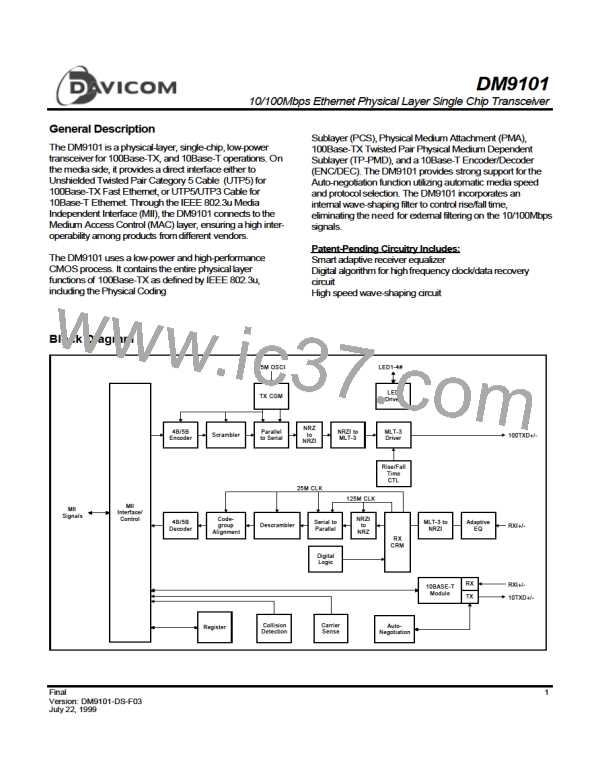DM9101
10/100Mbps Ethernet Physical Layer Single Chip Transceiver
Clock Recovery Module
The T/R symbol pair is also stripped from the nibble
The Clock Recovery Module accepts NRZI data from the
MLT-3 to NRZI decoder. The Clock Recovery Module
locks onto the data stream and extracts the 125Mhz
reference clock. The extracted and synchronized clock
and data are presented to the NRZI to NRZ Decoder.
presented to the Reconciliation layer.
10Base-T Operation
The 10Base-T transceiver is IEEE 802.3u compliant.
When the DM9101 is operating in 10Base-T mode, the
coding scheme is Manchester. Data processed for
transmit is presented to the MII interface in nibble format,
converted to a serial bit stream, then Manchester
encoded. When receiving, the Manchester encoded bit
stream is decoded and converted into nibble format for
presentation to the MII interface.
NRZI to NRZ
The transmit data stream is required to be NRZI encoded
in for compatibility with the TP-PMD standard for
100Base-TX transmission over Category-5 unshielded
twisted pair cable. This conversion process must be
reversed on the receive end. The NRZI to NRZ
decoder, receives the NRZI data stream from the
Clock Recovery Module and converts it to a NRZ
data stream to be presented to the Serial to Parallel
conversion block.
Collision Detection
For half-duplex operation, a collision is detected when the
transmit and receive channels are active simultaneously.
When a collision has been detected, it will be reported by
the COL signal on the MII interface. Collision detection is
disabled in Full Duplex operation.
Serial to Parallel
The Serial to Parallel Converter receives a serial
data stream from the NRZI to NRZ converter, and
converts the data stream to parallel data to be
presented to the descrambler.
Carrier Sense
Carrier Sense (CRS) is asserted in half-duplex operation
during transmission or reception of data. During full-duplex
mode, CRS is asserted only during receive operations.
Descrambler
Auto-Negotiation
Because of the scrambling process required to control the
radiated emissions of transmit data streams, the receiver
must descramble the receive data streams. The
descrambler receives scrambled parallel data streams
from the Serial to Parallel converter, descrambles the data
streams, and presents the data streams to the Code
Group alignment block.
The objective of Auto-negotiation is to providea means to
exchange information between segment linked devices
and to automatically configure both devices to take
maximum advantage of their abilities. It is important to note
that Auto-negotiation does not test the link segment
characteristics. The Auto-Negotiation function provides a
means for a device to advertise supported modes of
operation to a remote link partner, acknowledge the
receipt and understanding of common modes of
operation, and to reject un-shared modes of operation.
This allows devices on both ends of a segment to
establish a link at the best common mode of operation. If
more than one common mode exists between the two
devices, a mechanism is provided to allow the devices to
resolve to a single mode of operation using a
Code Group Alignment
The Code Group Alignment block receives un-
aligned 5B data from the descrambler and converts
it into 5B code group data. Code Group Alignment
occurs after the J/K is detected, and subsequent
data is aligned on a fixed boundary.
4B5B Decoder
predetermined priority resolution function.
The 4B5B Decoder functions as a look-up table that
translates incoming 5B code groups into 4B (Nibble) data.
When receiving a frame, the first 2 5-bit code groups
received are the start-of-frame delimiter (J/K symbols).
The J/K symbol pair is stripped and two nibbles of
preamble pattern are substituted. The last two code
groups are the end-of-frame delimiter (T/R symbols).
18
Final
Version: DM9101-DS-F03
July 22, 1999

 ETC [ ETC ]
ETC [ ETC ]